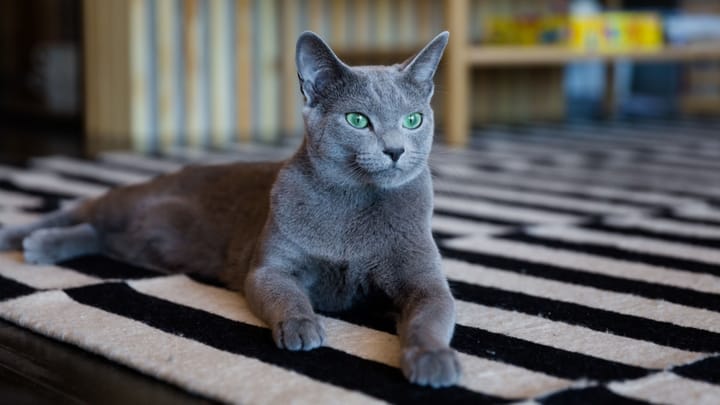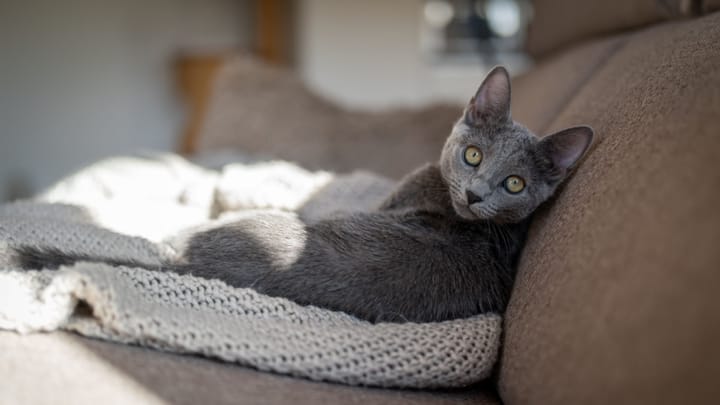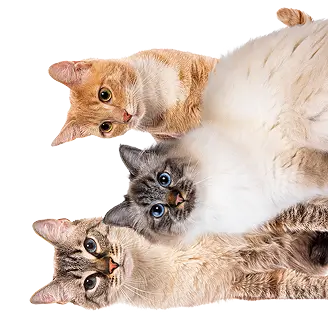Russian Blue
Other names : Russian, Maltese Blue, Norwegian Blue


This elegant feline with a dark blue coat, which appears to be sprinkled with silver, loves to cuddle. Quiet and reserved, the Russian Blue will be the perfect companion to anyone that will offer their time and a tranquil home. This cat is not designed for a hectic and busy life.
|
Life expectancy |
The Russian Blue has a life expectancy of between 13 and 20 years |
|
Temperament |
|
|
Adult size |
Female
Approximately 12 in
Male
Approximately 12 in
|
|
Adult weight |
Female
Between 4 and 7 lb
Male
Between 7 and 11 lb
|
|
Coat colour
Black / seal, blue / grey-slate, white The Governing Council of the Cat Fancy (GCCF) permits all the above colours. Other federations - such as the American one - only permit blue. In competition, judges generally look for the clearest shades of blue. Blue and white coated cats appear shiny as their hairs are silver tipped. Seal coloured cats have hairs that are black at the root. |
Black White Blue |
|
Type of coat
Their coats are short and dense as they have a thick undercoat. |
Short |
|
Eye colour
Their eyes should be as intense green as possible. |
Green
|
|
Purchase price |
The Russian Blue costs between £350 and £800 |
There is a variety of Russian Blue with mid length fur. They are known as Nebelung cats, which means "creature of the mist" in German. This variety was born in the 80s in the United States. The blue color is still dominant, although generally a lighter shade but, like its cousin, the Nebelung only exists in blue.
More details about the Russian Blue
Russian Blue: Origins and history
Like many other cat breeds, mystery surrounds the origins of the Russian Blue. No one knows whether it is Soviet, British, Scandinavian or even Mediterranean! One of the first hypotheses, and the most frequently cited, is that several individuals were imported from the Russian port of Arkhangelsk by sailors who sold them to the British in 1860. Like other breeds, the Second World War nearly wiped out the Russian Blue, but British and Scandinavian breeders kept them going. Several cross breeds, particularly with Siamese, changed the standard of the Russian Blue in the '50s. In France, this gorgeous cat appeared over the last century but was only officially recognized in the 80s. Due to the of the colour of their coats, they were for a long time outshone by the Chartreux or even British breeds.
Physical characteristics of the Russian Blue
Russian Blues are elegant cats with graceful and muscular bodies. Their small round feet tip their long, thin legs. Their tails are thick at the base, and gradually narrow into a tapered point. Their physique is well proportioned, and their faces are angular. The corners of their mouths are slightly raised, giving them their charming smiles. Their straight noses and wide foreheads meet at a convex angle at their eyebrows and their ears are as long as they are wide.
Russian Blue: Characteristics
Russian Blue: Behaviour
Breed compatibility Russian Blue
Russian Blue: Purchase price
A Russian Blue kitten costs between £350 and £800 depending on their lineage, upbringing, age and sex. They cost around £25 / month to keep them healthy, and to provide them with high quality food.
Russian Blue: Shedding
Light
This breed doesn’t lose much hair. Regular brushing will prevent the formation of hairballs in the cat’s intestines.
Russian Blue: Grooming
A simple weekly brush is enough to maintain the beautiful silver fur of the Russian Blue. A weekly ear and eye cleanliness check is also required.
Russian Blue: Health
13 to 20 years on average. They are generally robust cats.
Their fur allows them to resist cold weather. Historically, they were hunted due to the excellent insulating and waterproof qualities of their fur.
Their big appetites can cause obesity if not monitored and controlled. Interactive bowls are highly recommended to manage their food consumption levels.
The Norwegian Blue is not subject to any hereditary diseases, and is not predisposed to other particular disease. They are still at risk of developing the same illnesses as other cats though, such as oral problems.
The GCCF permits cross breeding between two Russians Blues only.






